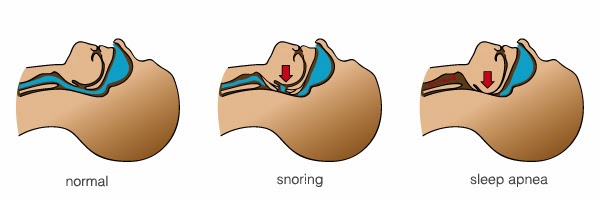Sleep apnea is
when there is a pause in breathing while asleep. There are 3 different kinds of sleep anpea – obstructive,
central and mixed. Obstructive is
when the airway has become narrow, blocked or floppy. Central is when the brain temporarily stops sending

It is estimated that between 3% and 7% of the population have OSA but this number could be higher as many people do not seek treatment. Older men who are obese are more likely to have sleep apnea, but it can effect women and any age group including children.[i] Obesity is the biggest risk factor for OSA so it is projected that OSA will become more common as the population becomes bigger and bigger.
OSA can cause
increased blood pressure and is associated with an increased risk of cardiovascular
disease.[ii]
It is also associated with an
increased risk of stroke, daytime drowsiness, motor vehicle accidents and lowered
quality of life.[iii] Rates of depression are also higher in
people with OSA so it is very important to seek treatment.[iv]
Treatments
 Starting to exercise
is the first place to begin if you have OSA. Studies have found that OSA improved even when participants
didn’t lost weight.[v] This can have a big effect on improving
overall quality of life as decreased OSA will result in a better sleep leading
to more energy during the day.
Then you will be able to exercise more! You want to do at least 150 minutes of moderate intensity
exercise a week. See my blog article on exercise for weight loss for more details.
Starting to exercise
is the first place to begin if you have OSA. Studies have found that OSA improved even when participants
didn’t lost weight.[v] This can have a big effect on improving
overall quality of life as decreased OSA will result in a better sleep leading
to more energy during the day.
Then you will be able to exercise more! You want to do at least 150 minutes of moderate intensity
exercise a week. See my blog article on exercise for weight loss for more details.
Studies have shown
that acupuncture and herbal medicine are both safe and effective treatment
options for OSA.[vi] [vii]
It is also
important to avoid sleeping on your back.
Purchase a pillow that encourages you to sleep on your side or you can sew
a tennis ball into the back of your pyjamas to keep yourself on your side. Avoid alcohol. Drinking alcohol within 6 hours of
sleep will worsen sleep apnea. Quit smoking. Easier said than done, but smoking is another major risk
factor for OSA.
If you think you
may have OSA it is important to see your healthcare provider as even mild cases
are associated with increased morbidity.[viii]
For natural treatments, contact
your local naturopath and start on your path to better sleep and better health.
References:
[i] Patil SP, Schneider H, Schwartz AR, Smith PL. Adult obstructive sleep apnea: pathophysiology and
diagnosis. Chest.
2007 Jul;132(1):325-37.
[ii] Phillips CL, Cistulli PA. Obstructive sleep apnea and hypertension:
epidemiology, mechanisms and treatment effects. Minerva Med. 2006 Aug;97(4):299-312.
[iii] Young T, Peppard PE, Gottlieb DJ. Epidemiology of obstructive sleep apnea: a
population health perspective. Am J Respir
Crit Care Med.
2002 May 1;165(9):1217-39.
[iv] Ejaz SM, Khawaja IS, Bhatia S, Hurwitz TD. Obstructive sleep apnea and depression: a review. Innov Clin
Neurosci.
2011 Aug;8(8):17-25.
[v] Kline CE, Crowley EP, Ewing GB, Burch JB, Blair SN, Durstine JL, Davis JM, Youngstedt SD. The effect of exercise training on obstructive sleep
apnea and sleep quality: a randomized controlled trial. Sleep. 2011 Dec 1;34(12):1631-40.
[vi] Freire AO, Sugai GC, Chrispin FS, Togeiro SM, Yamamura Y, Mello LE, Tufik S. Treatment of moderate obstructive sleep apnea
syndrome with acupuncture: a randomised, placebo-controlled pilot trial. Sleep Med. 2007 Jan;8(1):43-50.
[vii] Wu YH, Wei YC, Tai YS, Chen KJ, Li HY. Clinical outcomes of traditional Chinese medicine
compound formula in treating sleep-disordered breathing patients. Am J Chin
Med. 2012;40(1):11-24.
[viii] Young T, Peppard PE, Gottlieb DJ. Epidemiology of obstructive sleep apnea: a
population health perspective. Am J Respir Crit Care Med. 2002 May 1;165(9):1217-39.